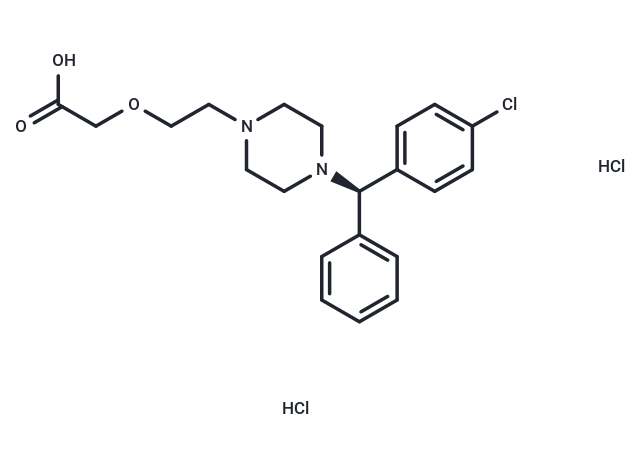Shopping Cart
Remove All Your shopping cart is currently empty
Your shopping cart is currently empty
Levocetirizine Dihydrochloride (Xyzal Dihydrochloride) is a third-generation peripheral H1-receptor antagonist. Acting as an antihistaminic agent, it specifically targets the histamine H1-receptor. Levocetirizine Dihydrochloride is the R-enantiomer of Cetirizine, which gives it a higher affinity for the H1-receptor than the S-enantiomer. Due to this enhanced affinity, Levocetirizine Dihydrochloride is effective in treating allergic rhinitis and chronic idiopathic urticaria.

| Pack Size | Price | USA Warehouse | Global Warehouse | Quantity |
|---|---|---|---|---|
| 25 mg | $42 | In Stock | In Stock | |
| 50 mg | $60 | In Stock | In Stock | |
| 100 mg | $85 | In Stock | In Stock | |
| 500 mg | $197 | - | In Stock | |
| 1 mL x 10 mM (in DMSO) | $29 | In Stock | In Stock |
| Description | Levocetirizine Dihydrochloride (Xyzal Dihydrochloride) is a third-generation peripheral H1-receptor antagonist. Acting as an antihistaminic agent, it specifically targets the histamine H1-receptor. Levocetirizine Dihydrochloride is the R-enantiomer of Cetirizine, which gives it a higher affinity for the H1-receptor than the S-enantiomer. Due to this enhanced affinity, Levocetirizine Dihydrochloride is effective in treating allergic rhinitis and chronic idiopathic urticaria. |
| In vivo | Levocetirizine (0.4 mg/kg; oral administration; male Sprague-Dawley rats) yields a Cmax of 0.34 μg/mL, an AUC0-t of 3.26 μg h/mL, an AUC0-∞ of 3.67 μg h/mL, and a t1/2 of 2.34 hours in Sprague-Dawley rats[1]. |
| Synonyms | Xyzal Dihydrochloride, (-)-Cetirizine Dihydrochloride |
| Molecular Weight | 461.81 |
| Formula | C21H27Cl3N2O3 |
| Cas No. | 130018-87-0 |
| Smiles | O=C(O)COCCN1CCN([C@@H](C2=CC=C(Cl)C=C2)C3=CC=CC=C3)CC1.Cl.Cl |
| Relative Density. | no data available |
| Color | White |
| Appearance | Solid |
| Storage | Powder: -20°C for 3 years | In solvent: -80°C for 1 year | Shipping with blue ice/Shipping at ambient temperature. | |||||||||||||||||||||||||||||||||||
| Solubility Information | H2O: 90 mg/mL (194.89 mM), Sonication is recommended. DMSO: 50 mg/mL (108.27 mM), Sonication is recommended. | |||||||||||||||||||||||||||||||||||
| In Vivo Formulation | 10% DMSO+40% PEG300+5% Tween 80+45% Saline: 2 mg/mL (4.33 mM), Sonication is recommended. Please add the solvents sequentially, clarifying the solution as much as possible before adding the next one. Dissolve by heating and/or sonication if necessary. Working solution is recommended to be prepared and used immediately. The formulation provided above is for reference purposes only. In vivo formulations may vary and should be modified based on specific experimental conditions. | |||||||||||||||||||||||||||||||||||
Solution Preparation Table | ||||||||||||||||||||||||||||||||||||
DMSO/H2O
| ||||||||||||||||||||||||||||||||||||
| Size | Quantity | Unit Price | Amount | Operation |
|---|

Copyright © 2015-2025 TargetMol Chemicals Inc. All Rights Reserved.